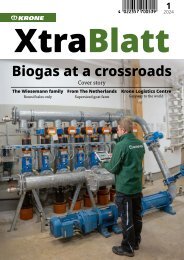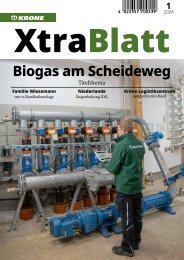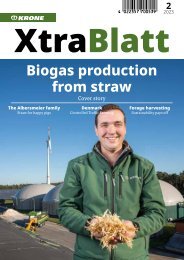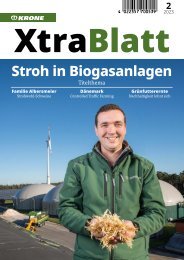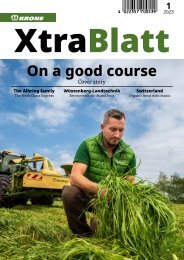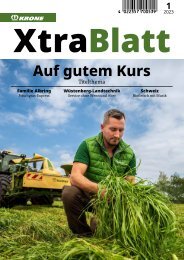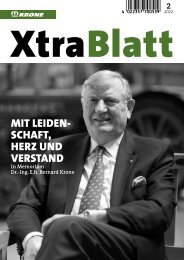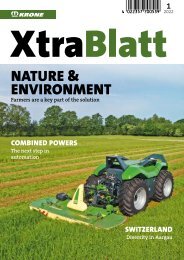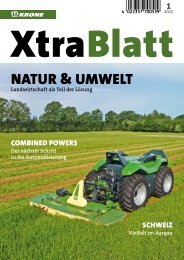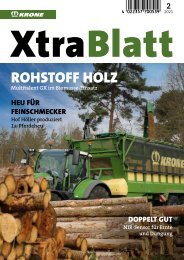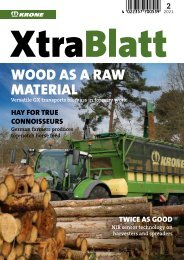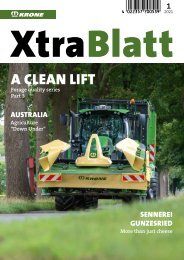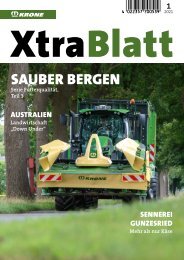XtraBlatt Issue 02-2020
Create successful ePaper yourself
Turn your PDF publications into a flip-book with our unique Google optimized e-Paper software.
TITLE THEME<br />
SOLD TO BUTCHERS<br />
However, the vaccine production came to an end in the<br />
mid-70s by which time the substance could be synthesised.<br />
The slaughter facilities remained and continued to be used,<br />
although less by the regional butchers and instead almost<br />
exclusively by a large slaughter company. Slaughter headage<br />
increased continuously. In 1981, the centenary of the original<br />
slaughterhouse, throughput numbered some 28,000<br />
cattle, 36,500 pigs and 2,000 calves. Investment was also<br />
a continuous process. Despite ongoing progress, doubts<br />
were being voiced about the future. The slaughter company<br />
profited, but Fürth had to keep paying upkeep.<br />
“The showdown came in 1984”, explains Konrad Ammon<br />
jn, independent master butcher and managing director<br />
of the Metzger Slachthof Betriebs GmbH. “Although Fürth<br />
showed willingness to be very generous in financial terms,<br />
the large concern at that time shut down operations. Our<br />
slaughterhouse was threatened with the same fate as that<br />
of nearly all other earlier slaughter facilities in the region:<br />
Schwabach, Weißenburg, Gunzenhausen, Ansbach, Lauf<br />
and Nürnberg. The last remaining municipal facility, in<br />
Erlangen, had not long before been sold<br />
to a private concern. But even before<br />
this, we regional butchers felt as if we<br />
were the “fifth wheel on the wagon”<br />
as far as the Fürth slaughterhouse was<br />
concerned. Despite this, it became very<br />
important for us to retain a regional<br />
supply source, as well as keeping the<br />
This picture of the<br />
slaughterhouse cutting line<br />
with its modern equipment<br />
was taken before the<br />
corona crisis. Nowadays the<br />
workers naturally wear face<br />
masks.<br />
“AS SELF-EMPLOYED<br />
MASTER BUTCHER THIS<br />
REGIONAL SLAUGHTER-<br />
HOUSE IS ENORMOUSLY<br />
IMPORTANT FOR ME.”<br />
KONRAD AMMON JN.<br />
facility’s work and training opportunities. On the initiative<br />
of my father, 55 professional colleagues joined forces and<br />
took over the municipal facilities with a deposit of 2000<br />
DM per person.”<br />
NEW CONSTRUCTION<br />
Thankfully, things went well for the butchers’ slaughterhouse.<br />
But there were always new hygiene requirements to be<br />
met and, soon, thoughts turned towards the construction<br />
of new premises. Fürth supported this ambition, offering a<br />
leasehold building site and financial aid. In January 1989,<br />
60 shareholders (50 butchers 10 livestock dealers, farmers<br />
and tripers) arranged construction of new facilities costing<br />
almost 5 m DM in the suburb of Burgfarnbach. No subsidies<br />
were available from the EU, federal government or state. By<br />
November 1993, the first test slaughter had been carried out.<br />
“We built a compact 7,500 m 2 floor area plant and stocked<br />
it with modern equipment”, recalls Konrad Ammon. In<br />
2019 we slaughtered almost 61,000 pigs, 3,800 cattle and<br />
1,600 sheep with throughput being slightly increased<br />
every year, a performance that strengthened our resolve to<br />
make what turned out to be the right<br />
strategic decisions. We re-organised into<br />
two businesses: the Betriebs GmbH that<br />
takes care of the entire infrastructure,<br />
and the Fürther Lohnschlächter GmbH,<br />
a company contracted for the actual<br />
slaughter work with 15 specialists from<br />
the region, all butchers with master<br />
All three with master butcher certificates (l – r): son Maximilian, daughterin-law<br />
Geli and Konrad Ammon jn. Together they manage the family<br />
butchery in Fürth-Burgfarnbach.<br />
certificates. Current shareholders total 105. In our customer<br />
files we have 330 addresses: butchers, livestock dealers,<br />
farmers with direct marketing, catering facilities and also<br />
associations that perhaps buy just a single suckling pig each<br />
year for their annual company dinner. Naturally, we are EU<br />
certified, fulfil the QS (national quality programme for farm<br />
produce) requirements and are also licensed to slaughter organically<br />
raised animals. Four specially appointed inspectors<br />
are responsible for the welfare of all animals.”<br />
Fulfilling the highest meat quality requirements means<br />
continuous investment to meet welfare, hygiene and environment<br />
protection requirements, as well as improving<br />
resource and energy efficiency in our operations, explains<br />
Konrad Ammon, adding: “For the current year we’ve budgeted<br />
5.5 m € for investments. For instance, we’re enlarging<br />
lairage area for pigs and improving intake facilities for cattle<br />
and pigs. On top of this, cooling capacity is being increased,<br />
the conveying system for carcasses automated so that<br />
cooling is accelerated. In total we are modernising the entire<br />
cooling plant to the latest technical and energy-efficiency<br />
standards. Another development: a stand-alone tripery<br />
for processing inner organs and intestines. Finally, we are<br />
restructuring product input and output facilities”.<br />
REGIONAL QUALITY<br />
“This regional slaughterhouse is extremely important for<br />
me as self-employed master butcher”, emphasises Konrad<br />
Ammon. He is the fourth generation to manage the family<br />
business in Burgfarnbach. And the next generation is already<br />
in-place too: both his sons are master butchers and a daughter-in-law<br />
a certified butchery salesperson as well as master<br />
butcher. The young ones have already taken responsibility<br />
and management of the butchery business into the fifth<br />
generation. The product range is wide. Alongside shop sales<br />
and party and delivery services, there’s a cook on the payroll<br />
to produce regular meals with daily menu changes for the<br />
staff. “We slaughter around eight to twelve pigs and one<br />
cattle beast per week”, calculates Konrad Ammon, adding<br />
that these slaughter animals have been ordered from the<br />
same farmers in the surrounding regions for years now,<br />
forming an unofficial partnership between firm and farmers.<br />
Thereby, the butcher has an influence on management and<br />
feeding of the livestock earmarked for delivery and therefore<br />
knows what he gets and gets what he wants in terms of<br />
quality for his customers. “For instance, I like to have slightly<br />
heavier than standard pigs with a slaughter weight of from<br />
105 to 110 kg. With cattle I put a lot of value in producing<br />
from beef breeds. Young bulls we do not slaughter at all.<br />
Getting our animals from large-scale farming operations<br />
wouldn’t work for us. The low numbers we slaughter weekly<br />
mean small operations are best suppliers. Here, the in and<br />
out system is mostly followed. I arrange the transport<br />
myself. In the slaughterhouse, there’s a lairage area with<br />
straw bedding and with feed and water available so that,<br />
as far as possible, any stress is avoided with the animals.<br />
After slaughter, carcass quarters or halves are transported<br />
to us for further work.”<br />
“The requirements of our customers have changed”, continues<br />
Konrad Ammon. “Nowadays, sausage is no longer sold<br />
in 100 g portions but instead in single slices of different<br />
sausage. This is more complicated for us, but I realise that<br />
our customers put a lot of thought into what they buy.<br />
There are others that simply go by price – although these<br />
are not necessarily our usual customers. But even those<br />
clients have to be somehow serviced too. This is why there’s<br />
also a place in the market for the large slaughter concerns<br />
and discounters. However, we choose another route – a<br />
way that’s luckily appreciated by our customers. Hereby<br />
the regionally reared animals we slaughter ourselves are<br />
an important component in the comprehensive range of<br />
quality ware we present to our customers.” «<br />
8 9



